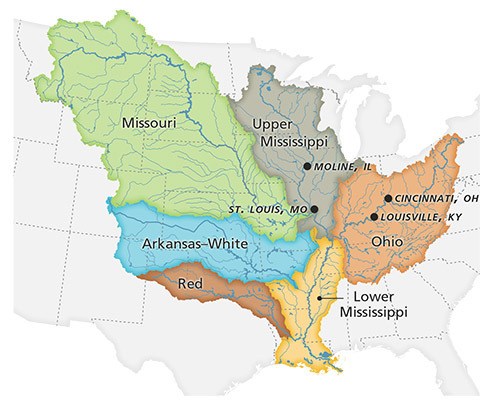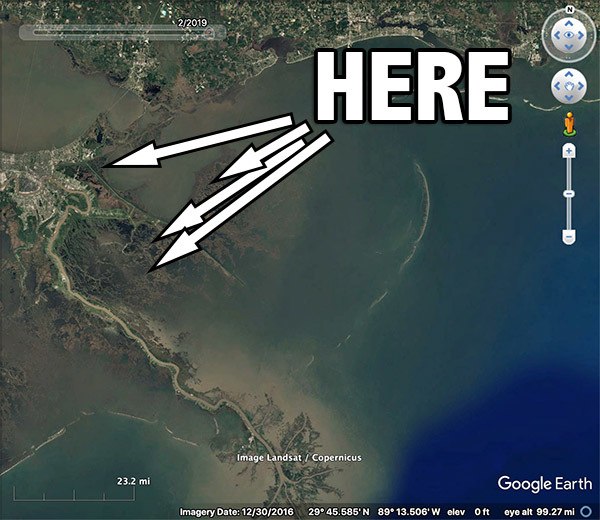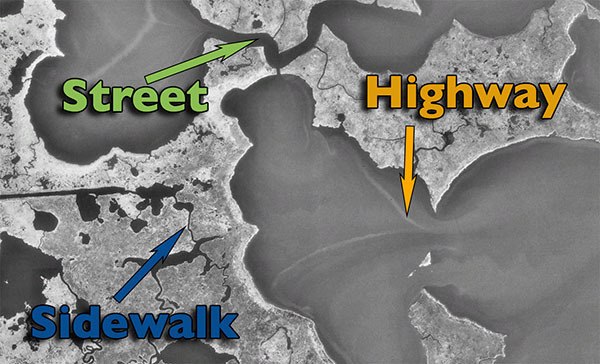The speckled trout spring pattern is productive, but poses its own unique challenges from the rest of the year. In this guide you will learn what you need to know: the behavior of speckled trout, where to find them and which tackle works best. Be prepared to use your tabs, because there's a lot of useful resources linked in below!
Everything You Need To Successfully Catch Speckled Trout During The Spring Pattern On Louisiana's Coast
It's that time of year when the grass is growing greener, flowers are blooming and the weather is just plain nice outside! Perhaps you're getting your boat ready because the fishing is stepping up and you want to know where some trout are.
Well, you've come to the right place, not just to find good fishing spots, but find good fishing spots on your own. So, let's get started by detailing the speckled trout spring pattern in these steps, or use the menu below to jump to your favorite part.
Why See The Big Picture?
The marsh is like a giant puzzle, with things like conditions and fish behavior being the smaller pieces you must put together. Perhaps you've put together a few puzzles and know you can look at the box it came in to see what it looks like when finished.

Sometimes you just need that one piece of fishing knowledge to unlock the pattern. You will find it here in this guide!
Without that "bigger picture" it'd be pretty hard to identify the pieces you need to complete the puzzle because you'd have no idea what you're putting together in the first place!
The Bigger Picture of the Speckled Trout Spring Pattern
It's simple:
Speckled trout have woken from their winter slumber deep inside the marsh and are preparing for the summertime spawn by eating a lot and migrating towards saltier water outside of the marsh.
Pretty easy, right? But how did they end up in the marsh in the first place? Let's cover that next.
Brief Rundown Of The Speckled Trout Winter Pattern
During the winter time, when water temps were in the mid-40s to low-50s, speckled trout were found hiding out in deep and stable "holes" inside the marsh. It's in these spots they hunkered down to hide from rapidly dropping water levels and temperatures brought on by cold fronts.

Once the front passed and weather stabilized, they'd come out to feed, mostly on demersal finfish since the fall shrimp migration has long since been over. When they do, it will be for short periods of time, since they are in "survival mode" and don't have to do anything but make it through the winter. But, with the coming of spring, their priorities change.
Speckled Trout Spring Pattern Begins
The spring pattern for speckled trout begins in March or April, depending on a couple conditions:
Important Details
To be clear, we like to see water temperature stabilized in the 60s, not brief spikes of warm weather.

A great example of stable, but rising, water temperatures. Note the time period.
After that, we look for the photoperiod to grow longer (photoperiod is just a fancy ten dollar word describing the length of day).
Dominant Weather Patterns
Just like winter, the dominant weather pattern of the speckled trout spring pattern is the cold front. Several conditions change when they sweep across the marsh:
Though not all cold fronts are the same, they all tend to drop the water level, cool it down, make it dirty (though not everywhere), and cause light conditions to go from overcast to bluebird. As they do, speckled trout speckled trout will react accordingly, as they did during the winter pattern.
By now you're probably thinking, "Light conditions?!"
Yes, this is a condition often overlooked by inshore anglers, though it's a huge player in how fish feed, especially for speckled trout.
Want to learn why trout like certain light conditions over others? Just click here.
Don't Forget Rain!
Rain is a big factor we must pay attention to! No, not the rain landing in the marsh, but rain that's been falling across the United States all winter long, and the snow that melts once spring arrives.

All that water eventually drains to the Mississippi River and will come our way to Louisiana, raising the river level as it does. This additional river water flows across the marsh and open bays, causing speckled trout to depart for cleaner and saltier waters. If there's enough rain, spillways will be opened, dumping additional river water into the surrounding area.


Note Concerning Long Term Mississippi River Cycles
The Mighty Mississippi does not flood and recede the same amount at the same time each year. Each year is different, and it really depends on how much rainfall the North American continent sees. For example, during the late 90s and early 2000s, we saw an unusually low river that resulted in a phenomena I have termed a saltening. When this happened, the speckled trout fishing was the best we had seen in a very long time and, simultaneously, many state record speckled trout were landed.
The opposite of a saltening would be a freshening, and we had one occur from 2011 to 2020. This significantly impacted our speckled trout fishing in a bad way, ultimately resulting in lower numbers and a reduction in the speckled trout creel limit. I wrote about The Freshening in this article, and there you will find lots of graphs and evidence to support my idea.
But where are we now? Well, it appears we are in another Saltening, and you can learn more about it in this article.
Primary Forage
So far we know how river water, cold fronts and the need to spawn will cause speckled trout to behave. But what about food? Speckled trout have to eat, and knowing what they will eat is key to knowing where they will be.

Yes, speckled trout like croakers, but they are not the only bait they eat!
Brown Shrimp Migration
During the spring, especially in May, there's a strong run of brown shrimp through the marsh. This is because they're leaving the marsh for the Gulf of America, where they will spawn and send small, baby shrimp into the marsh where they grow and start the process all over again. During this migration brown shrimp become vulnerable to hungry speckled trout.
Pelagic Finfish
It's also during the speckled trout spring pattern we see juvenile pogies (aka Gulf Menhaden) and finger mullet swimming about, a product of their respective species winter spawn.

Bite size shad like this guy are irresistible to speckled trout.
These fish are typically found in open water near the surface, sometimes relating to a shoreline, but not always. Gizzard shad are another species, commonly mistaken for menhaden (which are targeted by the infamous "pogey boats").
The term "pelagic" is not commonly used in inshore fishing.
But, it's being used here to differentiate pogies and mullet from demersal species like violet gobies, cocahoes (aka killifish), and croakers.
Since they both swim and feed in different parts of the water column, they both influence trout behavior in different ways.
In turn, this influences the tackle, lures and presentation used to catch those trout.
Demersal Finfish
These are baitfish that live and feed on or near the bottom of the water. These include:
It's safe to say that speckled trout have a long menu to choose from, and which one they choose will dictate where and how they feed, so let's jump into that.
Speckled Trout Location During Spring
This is where the rubber meets the road! Everything we've covered up until this point is key for two reasons:
- eliminating unproductive water
- zeroing in on the most productive water
So, if you skipped over all that stuff, do yourself a huge favor, scroll up and catch up on it.
Where Speckled Trout Begin The Spring Pattern
Because we know what trout were doing during the winter time, we know they are starting spring deep inside the marsh.

Where Speckled Trout End The Spring Pattern
And because we know where they need to go to spawn, we have a good idea as to where they will end up.

Hone In On Exact Fishing Spots By Understanding What Bait Speckled Trout Are Eating
Speckled trout behavior before, during and after a cold front is pretty straightforward, but how they behave when feeding on different bait is different, so let's knock that out.
Speckled Trout Feeding on Shrimp
Where brown shrimp flow is fairly predictable because they cannot swim well under their own power. Instead, they use the tide to exit the marsh, and where we find the tide flowing, we will find shrimp!

Shrimp flow so predictably that fishermen put stationary wing nets out to catch them.
What's cool is that this flowing water can be seen from a distance because it creates visible "lines" at the surface. We call these "tidelines".

"Highways" in the Marsh
Bodies of water can be categorized by how much water moves through them. A small bayou doesn't move a lot of water, so it is more like a "sidewalk" for fish to use. However, a large pass is more like a six-lane highway, because it moves a lot of water (and typically has large tidelines when it does).

If this concept is new to you, then you really ought to read this blog post about highways in the marsh. Anyway, locating these tidelines in the marsh is key to locating where brown shrimp will congregate and be fed upon by speckled trout. It's pretty much the same thing that happens with the white shrimp migration during fall.

Diving Birds
While I strongly recommend using tidelines to find feeding specks, diving birds are certainly the low hanging fruit. However, there's no point in hashing it out here, as an ultimate guide on fishing diving birds already exists.
Note on White Shrimp vs Brown Shrimp
I have found that white shrimp tend to penetrate further inside the marsh than brown shrimp. Yes, they can be found in places with very low salinity, so it's typical to find them far inside the marsh when fall begins. But this is not the case for brown shrimp!
I have observed brown shrimp being more toward the outside of the marsh when they begin their migration in spring. For example, I typically find them in saltier water in the East Biloxi Marsh in April and May, whereas I find white shrimp as far inside as the west side of Lake Pontchartrain during September and October.
So, if you remember catching speckled trout under shrimp somewhere deep inside the marsh during fall, I would not count to find them there doing the same thing when spring arrives!
Speckled Trout Feeding on Finfish
Pogies and mullet tend to get fed on when they get near the shoreline, or at least shallow water. When they do, it's pretty obvious. What's less obvious are the demersal finfish that are well under the water, but how do we find them?

Rocks like these make excellent homes for demersal finfish.
A lot easier than finding mullet or pogies, that's for sure! This is because they're attracted to places that offer them food to eat and cover from predators. Examples include:
Want to learn more? There's more detail in this blog post about demersal finfish and the winter pattern.
There is something very important you should know about demersal finfish!
They will influence not only where speckled trout are feeding, but also how they are feeding.
Example
In May 2018 there was a good run of speckled trout on the MRGO Long Rocks near Hopedale, Louisiana.
There were a lot of boats, and the majority of them were throwing live shrimp under a cork and not catching a thing.
How could this be?
It's all explained in this blog post about fishing the MRGO Long Rocks during the speckled trout spring pattern.
Best Tackle & Live Bait To Catch Springtime Speckled Trout
This section will be short because the best tackle you need to be using is already detailed in other guides.
Inshore Rig
The Inshore Rig is an all-around favorite for spinning tackle, because it doubles as two rigs, eliminating the need to have a second rod or retie. Click here to learn how to build an Inshore Rig.
Jigging Tackle
Jigging is – without a doubt – the best way to catch springtime speckled trout, especially in deep moving water. Here's a list of my favorite rod, reel and line for jigging.
Double Rig
Why catch one when you can catch two? It's hard to beat the catching ability of a Double Rig when the action gets hot and heavy. Click here to learn what you need to tie one.
K-Dub Rig
This features the same benefits of a Double Rig, but with the addition of a cork. Because of this, it's tied a little differently.
Drop Shot
The drop shot is a time tested finesse solution for finicky fish. However, there's only one way to tie it (well, a true drop shot anyway) and this guide shows you exactly how.
Heavy Drop Shot
The heavy drop shot is a great way to fish deeper water with tackle that is more rugged and, therefore, more dependable and practical to use. Learn my favorite way to tie it in this video guide.
Live Shrimp
Live shrimp is popular, but keeping them alive can be a pain. Here's a quick guide showing you the best way to do that. However, with that said, fishing with live shrimp is not necessary to catch limits of speckled trout this spring. Yep, I said it! If you're not sure, then these 11 reasons why may change your mind.
Live Croakers
Bite-sized croakers are irresistible to big speckled trout, and something you should consider using if you prefer live bait. This guide shows you the best way to rig them.
Learn How I Catch Fish From Scratch, Year Round
The speckled trout spring pattern is dictated by their need to spawn, prevailing conditions and primary forage. Master the ability to recognize these and you'll be on your way to locate and catch speckled trout all on your own!
But there's more to it..
There are many more things needed to make a successful (and safe) speckled trout trip happen:
These and more are what I teach in detail in my flagship course, Inshore Fishing 101. It's only available to members of LAFB Elite, so please consider the benefits of signing up.

Thanks for visiting!
good read devin
I hope so, too. Thanks for visiting LAFB, Jon!
great info!!! hope i get a chance to put some of your tips in play!
You have shared some important info that is really very helpful. Love to read. keep doing the great job.
Thanks for reading!
Very glad to hear this. Thank you so much for your support!
Devin this is awesome information. You have definitely succeeded in mastering the speckled trout game. I apply it in Savannah Ga the same as you in Louisiana . Please keep it coming and feel free to send anything helpful or extra thru email.
Thank you, Neil.
Good information as always. Thanks Devin
Thanks, Wayne.
Devin, this is a great read. Thank you for posting it. I look forward to trying the tackle suggestions, good stuff.